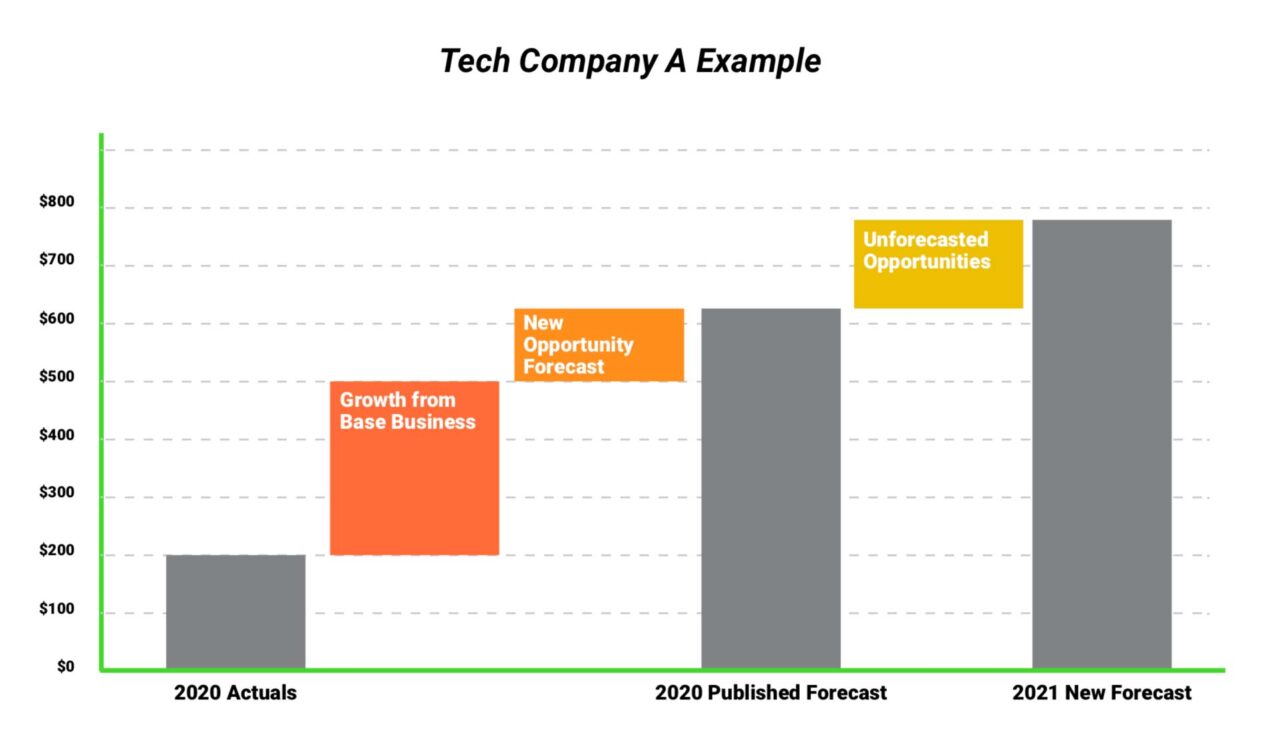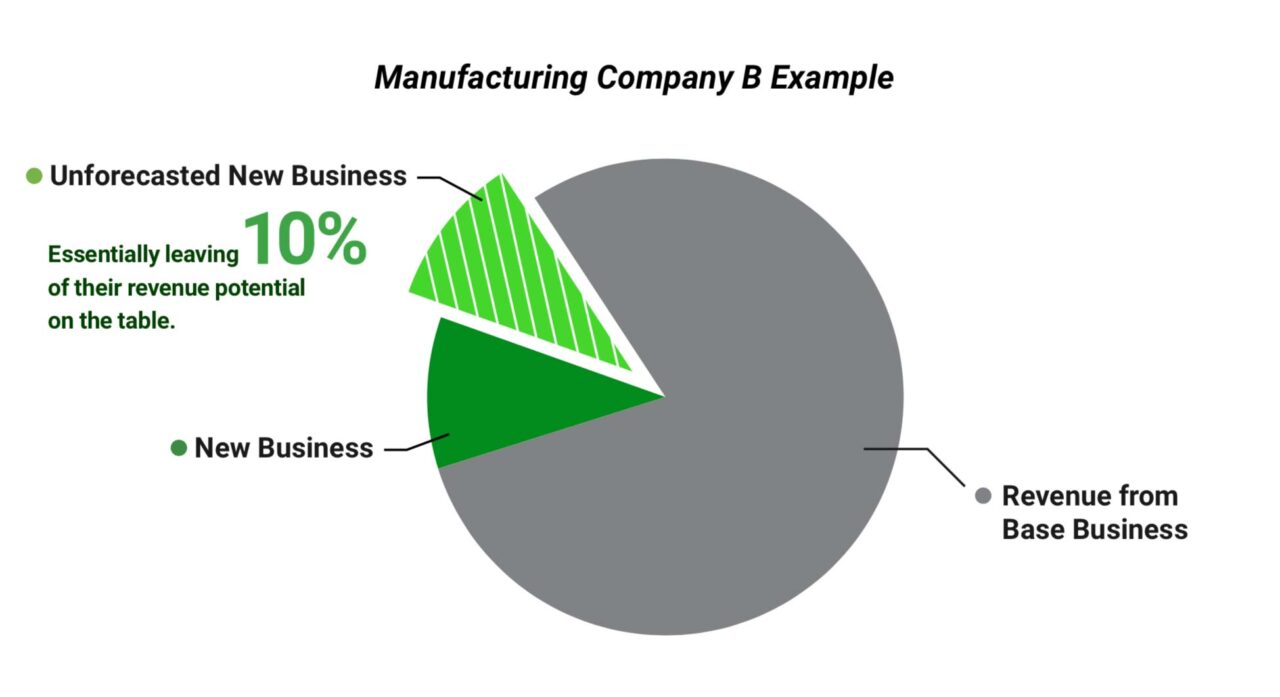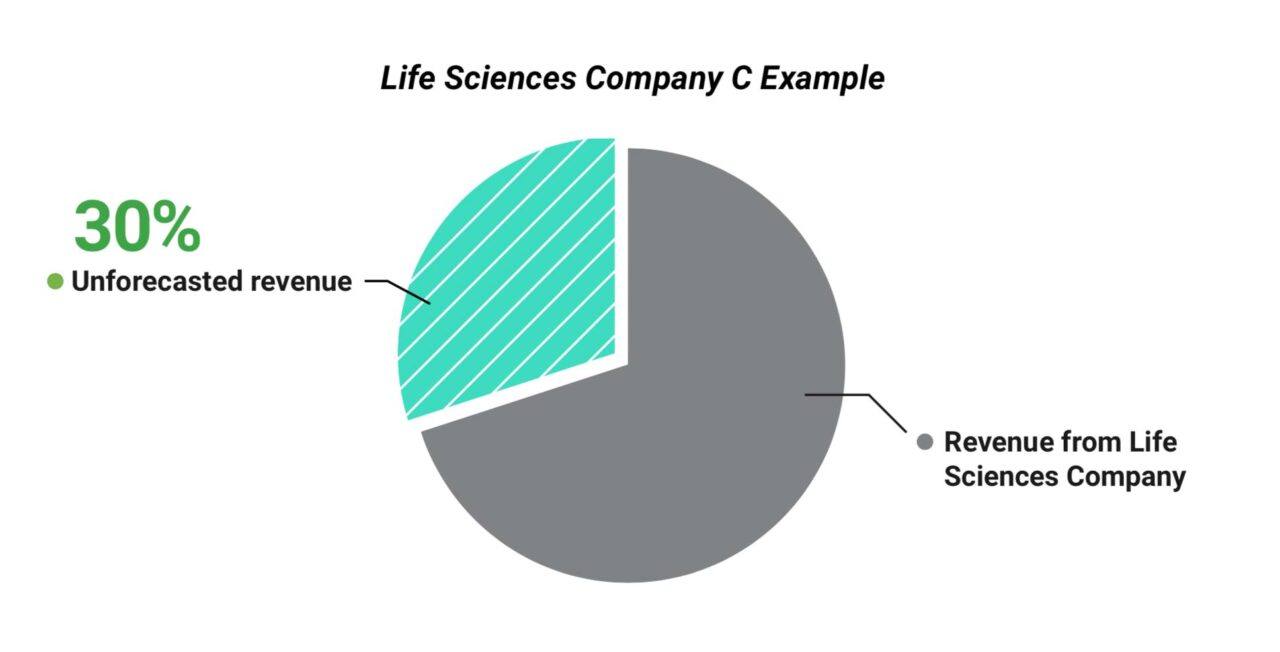Problems With Forecasting: Where Is Your Revenue Hiding?
Last updated on Monday, April 4, 2022
The Difference Between Your Sales Pipeline and Your Revenue Forecast
When it comes to navigating the challenges of forecasting, you must be able to differentiate between your sales pipeline and your pipeline forecast.
Sales Pipeline
A sales pipeline is the collection of potential sales opportunities that are currently in the process of converting to revenue.
Opportunities within a pipeline can range from those that have been recently identified to opportunities on the cusp of becoming a successful sale.
As a valuable metric in sales forecasting, all sales pipeline data should always be well documented and accessible using CRM applications in order to support future forecasting accuracy.
Pipeline Forecasting
Pipeline forecasting is the process of estimating the sales opportunities present at a given moment. Pipeline forecasting uses various pipeline data points, such as the rate at which opportunities enter the pipeline, to average a potential sale amount and predict the rate of which future opportunities may arise.
As with sales and revenue forecasting, you must understand where your sales pipeline currently stands to conduct pipeline forecasting, both of which aid in stronger revenue forecasting efforts.
However, one of the many forecasting problems encountered by organizations is a lack of current pipeline data for accurate pipeline forecasting. Incorporating both sales pipeline forecasting data with general historical revenue increases sales forecasting accuracy, but that’s only if all data is considered.
If your organization is struggling with pipeline forecasting and related financial inaccuracies,
it’s time to discover where your revenue is hiding. Here’s how to identify the gaps in revenue among your organization, and how these gaps may be impacting your business.
Four Primary Gaps Between Pipeline and Revenue Forecast
To meet growth goals, companies can’t let revenue slip through the cracks. Yet there are gaps between expected pipeline revenue and the revenue forecast that are costing companies millions of dollars — sometimes hundreds of millions of dollars — of revenue today.
For most companies that have revenue recognized or expected over time through bookings or subscriptions, these gaps appear between closed deals in Salesforce and the revenue forecast that leadership uses to base their decisions.
There are four primary gaps to be aware of:
- Limited ability to forecast revenue expected from sales
- No way to instantly adjust revenue forecasts when pipeline shifts or changes.
- Booked deals not delivering the expected revenue.
- No way to manage or forecast run-rate revenue directly in the CRM.
These forecasting challenges hide revenue opportunities from your sales team, while at the same time making the revenue forecast dangerously flawed.
No matter how diligently your sales team uses their CRM application, or how thorough your sales operations and finance/FP&A teams are with their spreadsheets, without closing these gaps and creating a seamless Sales-to- Finance feedback loop, your organization will continue to miss critical revenue opportunities.
Revenue anticipated from pipeline is a window into the effectiveness of the sales process, the productivity of the organization, and the health of the company as a whole.
Accurate, dynamic, real-time visibility to the revenue from pipeline has a direct bearing on the company’s ability to grow.
Yet most finance/FP&A teams don’t have this kind of visibility using their existing forecasting processes.

The Top 3 Financial & Operational Challenges of Forecasting
For most companies that have expected revenue over time through bookings or subscriptions, the gaps exist between expected pipeline revenue (usually tracked as closed opportunities in CRM applications) and the revenue forecast (usually produced via massive spreadsheets).
In fact, most companies don’t account for up to 80% of their sales pipeline data which can create significant problems in forecasting. Consider the top three financial and operational challenges of forecasting that could be leading to this massive omission of data.
1. A large percentage of pipeline data is left out of the revenue forecasting process
It’s a common practice in most industries to only define revenue for large deals while smaller deals are summed up and discounted for the purpose of revenue forecasting.
The more finance/FP&A teams can generalize, the faster the revenue forecasting process goes. Considering it can easily take an entire month to produce a single revenue forecast using spreadsheets and complex calculations, the faster you can get it done, the better. Sales data goes stale quickly.
The problem with the practice of discounting revenue for forecasting purposes is that it results in inaccurate forecasts.
When the forecast doesn’t take into account a significant portion of the pipeline, the company is ignoring top-line potential. This creates a gap by limiting Finance/FP&A’s ability to forecast revenue expected from the sales pipeline.
As a result, in the revVana’s team experience, most companies don’t account for up to 80% of their pipeline. Unsurprisingly, this further leads to a reduced ability to meet company targets that have been communicated to investors. As a consequence, an unexpected loss of investor funds creates a new forecasting challenge that will require full reassessment.

The primary reason why sales pipeline data is commonly left out is simply time. It takes time to analyze deals, especially using a manual spreadsheet process.
2. Vital pipeline data points including ramp time, deal changes, and lead-to-sale are left out
For companies that have revenue coming in over time through bookings or subscriptions, just because a deal is marked “closed” in Salesforce doesn’t mean the product is sold and revenue can be recognized.

For many businesses, a closed deal is only a commitment to buy. A lot can happen between when a sales rep closes a deal and when the revenue rolls in.
For some industries, like manufacturing, production-level volume on a deal might not happen for six to 12 months — or more. There may be an impact on business operations, such as supply chain and resource allocation, as well as delays in engineering, provisioning, or installation — any of which can delay revenue realization.
In other industries, such as life sciences, a closed deal is just the earned right to do business. The actual sale of the product is done through orders that are placed as the customer needs more product over time. The sales opportunity is just an estimate of annual or monthly business — the actual sale may be dramatically different than the data coming from the Salesforce opportunity.
This creates two gaps. The first is that there is no way to instantly adjust revenue forecasts when (not if) pipeline shifts. And second, it may result in booked deals not delivering the expected revenue.
3. Unorganized run-rate revenue tracking adds unnecessary complexity to the forecasting process
Modern CRM applications don’t typically track account-level revenue over time. This is revenue that is probably not related to an opportunity. Instead, most organizations track this legacy business through (yet more) spreadsheets — which take time to aggregate data and may have errors.

In short, there is no efficient feedback loop between Sales and Finance.
Adding more spreadsheets to an already cumbersome spreadsheet process slows everything down. The added administrative time creates more lag in the forecasting process, which means that the sales data is stale before the revenue forecast gets distributed.
This leaves the leadership team to make decisions based on sub-optimal forecasts, and it leaves the sales team with no visibility into where they should be spending their time and energy to move the company forward.
This creates a gap between how run-rate revenue is forecasted and how closed deals in CRM applications are forecasted — a gap ripe for errors. Even more, this decreases sales team effectiveness and productivity. When teams work in silos, each party works harder — but definitely not smarter.
The Effects of Pipeline Gaps
The gaps between pipeline and revenue forecast become a chasm between what’s happening in the business and the data being used to create the revenue forecasts. And when the people creating the revenue forecasts that the entire company relies upon don’t have crystal-clear visibility to accurate revenue data and insight — the whole company suffers.
Decreased Efficiency
The gap makes gathering all the necessary sales data a more manual and complex process for everyone involved. It’s obvious what administrative burden this puts on the sales operations and finance / FP&A teams — but the sales team is impacted as well.
It requires effort for the sales team to manage the complex process of tracking sales data, and that time and energy could be better utilized to sell more deals or close existing deals faster.
Manual spreadsheet processes also slow down Sales Operations, Finance, and Demand Planning. Creating data and analyzing it in giant spreadsheets — especially when the pipeline can’t be taken seriously — requires great effort yet results in less accuracy than a more automated approach.
Decreased Revenue Visibility
Without timely and accurate information, forecast generation times can’t keep pace with sales and planning cycles — and there’s no room for rapid response to changes in business.
This also means the sales team is working with plans that are off-target from commitments.
They have no easy way of knowing where their efforts would be best focused, and limited visibility to where they could better help the company reach its goals.
Without an accurate, real-time view of revenue, demand planning processes are also less effective. Inventory levels are harder to manage and customer satisfaction can take a hit.
Less Accurate Forecasting
No one likes a revenue forecast surprise — and yet for companies with huge gaps between pipeline and revenue forecast, surprises are par for the course.
The lag due to manual spreadsheets clouds the organization’s ability to understand the impact individual deals will have on meeting financial targets.
There’s simply no time to analyze more than the biggest deals. This also clouds the entire organization’s ability to understand why deals slip and aren’t realized.
The resulting blind spots can easily cost companies millions of dollars in unrealized revenue.
How the Gap Shows Up and Impacts Three Industries:
Technology, Manufacturing, and Life Sciences
Now that you have a solid understanding of what the gap is and how it can cost your company in lost revenue, let’s look at some real-world examples of how it shows up in three specific industries.

These are based on real experiences the revVana team has had with companies in these industries.
Technology
Timing is everything in technology sales. Closing deals is great, but the real growth power comes from knowing when the revenue from those deals will actually materialize.
Pipeline in this industry moves fast, and with traditional revenue forecasting processes, tracking corresponding revenue streams isn’t easy. It takes time to aggregate pipeline for future revenue, and by the time the revenue forecast is generated, the data is stale.
While stale forecasts can be a challenge in any industry, it hits technology companies particularly hard because they’re often growing rapidly, and pipeline is more crucial.
Let’s look at a SaaS company as an example:
Tech Company A software is immensely popular around the world, currently pulling in $200M in annual recurring revenue, and trying to grow 30-40% per year. About half of this growth is coming from new opportunities. Finance/FP&A was only including a percentage of that pipeline in their revenue forecasts to try to keep pace with the rapidly evolving business — leaving a massive gap between pipeline and revenue before revVana eliminated the manual data collection.

Valuation is a huge concern for many technology companies as well. If a company is closing deals but not seeing the revenue growth expected from those deals, it can jeopardize the company’s worth in the eyes of investors. This happens even in a straightforward licensing model.
Take another software company as an example. Even with a subscription model, the company still has a pipeline to consider with its enterprise products.
They have agreements with big companies that start with a certain number of licenses, and if that pilot goes well, the customer agrees to increase the number of licenses by 300%. In addition, usage-based licensing is more common in SaaS. Usage-based models that are not properly forecasted can lead to revenue forecast variances, especially with rapidly growing organizations.
Forecasting renewals becomes challenging for technology companies with subscription models as well. If renewals can’t be tracked in the CRM, there is yet another disconnect between sales data and the revenue forecast.
Licensing the software is straightforward, but as far as Finance is concerned, quickly aggregating the sales data and defining what the forecast will be is still a complex undertaking with the manual spreadsheet process.
For many technology companies, having a variety of deal types adds even more complexity to the revenue forecasting process. When deals come from bookings, indirect channels, renewals/replacements, and non- standard products, it’s difficult to calculate ACV (annual contract value) or TCV (total contract value).
And IoT companies have another challenge entirely. Revenue can lag due to delays in the installation of hardware. Often customers don’t pay for their services the hardware is installed, so whether the delay is on the company’s side or the customer’s, the company still feels the pinch from that revenue gap.
revVana automates revenue forecasting for rapidly growing technology companies and provides transparency to the numbers.
Manufacturing
In the manufacturing sales process, the sale is merely an agreement on price, plus possibly a ballpark estimate on order quantity and frequency. Real revenue can vary widely from what the sales team enters as a closed deal in the CRM.
Take a brake manufacturer as an example. When an automaker needs an order of brakes, they place a PO based on how many vehicles their demand plan requires. The brake manufacturer has no real way of knowing how many brakes the next PO will be for. They can make an educated guess at the future volume, but the automaker’s needs will determine what the brake manufacturer’s revenue will be.
To compensate for this disparity, the brake manufacturer’s finance/FP&A team estimates that the company will only see half of the revenue from the pipeline in Salesforce. That’s the starting point for the gap in the manufacturing industry.
But what happens when ramp time is longer than usual? Or if engineering challenges cause the details of the deal to change?
If the deal is an engineered product where engineers from the manufacturing company are working with engineers at the customer company to meet certain specifications, there can be delays due to unanticipated design challenges, or delays in the supply chain.
If the manufacturer can’t invoice for parts and services until the product is shipped, another gap is created between the pipeline and the revenue forecast.
The manual revenue forecasting process simply doesn’t allow for quickly generating new forecasts when deals change. So the company will almost always be operating from a revenue forecast that is inaccurate at best — or dangerously wrong at worst.
Here’s a real-world example to put this in context:
Manufacturing Company B is a large OEM manufacturer that sells to large industrial equipment manufacturers. The company does about $2.0B in revenue per year, and they count on $400M of that to come from net new business.
When we asked the leadership how much of that revenue they actually see, they assumed all of it. Yet when we spoke with the finance team, it became clear very quickly that the revenue forecast only accounted for half of that.
That meant $200M was unaccounted for in the revenue forecast, essentially leaving 10% of their revenue potential on the table. For a company trying to grow by at least 7% per year, that’s a very material gap.

An additional challenge creating gaps for manufacturing companies is run rate. There is often no system of record to allow Sales or Sales Operations to manage account-level run-rate revenue, which creates an additional blind spot for Finance/FP&A.
To solve these challenges for manufacturing companies, revVana enables automated, push-button revenue and demand forecasts out of Salesforce Sales Cloud for the finance and operations teams while giving the sales team visibility to run-rate revenue for their existing accounts.
Life Science
In the life sciences industry, account reps and other customer-facing teams are often managing account-level revenue. This creates a different dynamic for how sales data is gathered and tracked, but it still creates many of the same revenue forecasting problems that the manufacturing industry experiences.
For a company selling biotech equipment to a hospital, for example, as in manufacturing
the sale is an agreement on the price — not an agreement for a certain number of units. When the hospital has a need, they will place an order. The pipeline sales data in Salesforce is an estimate and doesn’t track revenue over time.
And like in manufacturing, finance/FP&A teams in life sciences companies are typically only including a portion of the pipeline in the revenue forecast. Unique to the biotech industry, however, is that sometimes revenue is not realized until the products are actually used by customers.
Here’s a recent example:
Life Sciences Company C was experiencing a gap in a particularly painful way. The company’s account team was missing their revenue forecasts by up to 30%. Like with most companies, the revenue forecast drove the sales targets. The finance team was aggregating hundreds of spreadsheets with weeks in delay in aggregating revenue forecasts for thousands of accounts between hundreds of sales reps. This is a $1.0B company, meaning their forecast variance would fluctuate by plus or minus $300 million. That is not pocket change.
That’s hundreds of millions of dollars that weren’t being accounted for in their top line plan.
For life sciences companies, revVana helps account teams manage their run rate and new product opportunity revenue in one place within Salesforce.

Closing the Gap Between Sales Pipeline and Revenue Forecast
Managing the revenue forecast with manual spreadsheets not only makes a company radically inefficient, but it also creates massive gaps between pipeline and revenue.
These gaps create blind spots not only for leadership but for the sales team as well.
revVana Plan works right inside Salesforce to automate the generation of revenue forecasts based on finance rules with accurate, up-to-date pipeline data.
This real-time revenue forecasting enables companies to identify revenue in the pipeline and activate the sales team to focus on the opportunities that will make the most impact. It’s a 360-degree view of revenue that dynamically adjusts to changes in opportunities and deals, keeping revenue forecasts in-sync with moving pipeline.
Additionally, revVana automatically updates the revenue forecast and takes snapshots of revenue forecasts at the time of booking — giving your organization crystal clarity around how changes in the pipeline are impacting the revenue forecast.
revVana Plan also provides account-level revenue tracking outside of the standard opportunity process, so your team can manage run rate revenue alongside pipeline revenue, streamlining your processes even further.
Closing the gaps between expected pipeline revenue and the revenue forecast with revVana creates a continual Sales-Finance feedback loop for booked deals. Your Sales and Finance teams will work together more effectively, creating new opportunities to capture revenue for the company.
Most importantly, the revVana app can be deployed in days, with no IT intervention and no additional effort from the sales team. Your organization can go from cumbersome, slow, incorrect revenue forecasts to dynamic, real- time, precise revenue forecasts in a matter of days.
What are you waiting for?
Problems With Forecasting: Where Is Your Revenue Hiding?
Published on Monday, April 4, 2022
